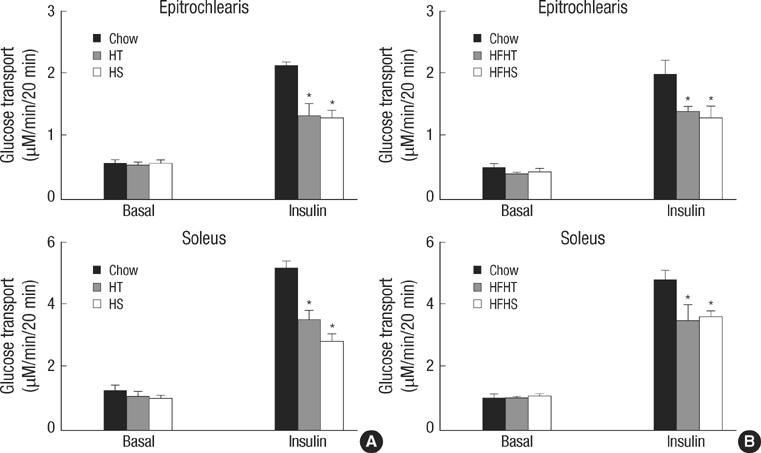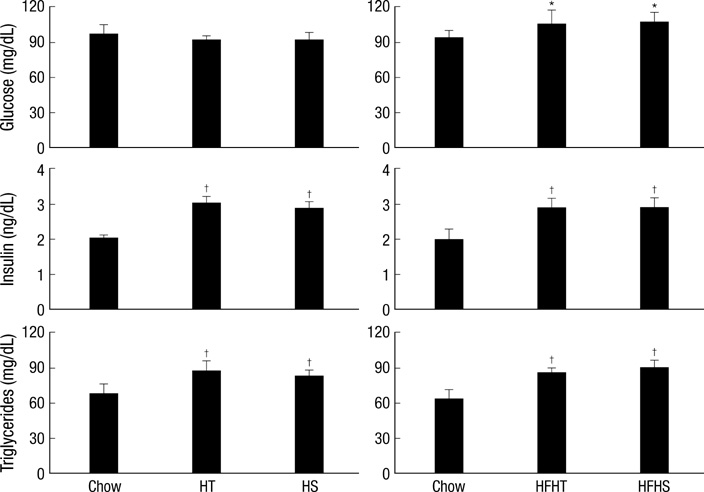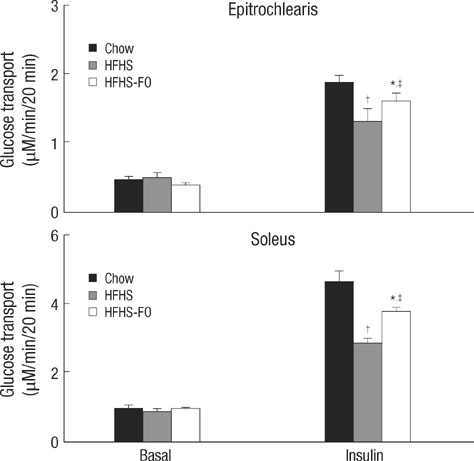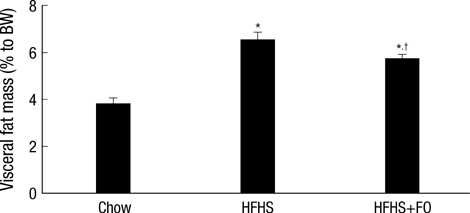J Korean Med Sci.
2010 Jul;25(7):1053-1059. 10.3346/jkms.2010.25.7.1053.
Differential Effects of High-carbohydrate and High-fat Diet Composition on Muscle Insulin Resistance in Rats
- Affiliations
-
- 1Obesity-Diabetes Advanced Research Center, School of Medicine, Yeungnam University, Daegu, Korea. jykim@ynu.ac.kr
- KMID: 1792956
- DOI: http://doi.org/10.3346/jkms.2010.25.7.1053
Abstract
- This study was conducted to evaluate whether the composition of carbohydrate or fat diet affects insulin resistance by measuring the muscle glucose transport rate. Both high-sucrose and high-starch diet with or without high-fat decreased insulin-stimulated glucose transport, but there were no significant differences among groups. Calorie intake in both high-sucrose and high-starch diet groups was higher than in chow group. The high-fat high-sucrose diet induced decrease in insulin-stimulated glucose transport was partially improved by supplement with fish oil. Calorie intake in high-fat high-sucrose and fish oil supplemented groups was higher than in chow group. The decreased insulin-stimulated glucose transport was accompanied by the increase in visceral fat mass, plasma triglyceride and insulin levels. These changes were improved by the supplement with fish oil. These results demonstrate that the composition of fat in diet is clearly instrumental in the induction of muscle insulin resistance. However, in high carbohydrate diet, it is likely that the amount of calorie intake may be a more important factor in causing insulin resistance than the composition of carbohydrate. Thus, the compositions of carbohydrate and fat in diet differentially affect on muscle insulin resistance.
MeSH Terms
-
Animals
Blood Glucose/metabolism
Body Weight
Diet
Dietary Carbohydrates/*pharmacology
Dietary Fats/*pharmacology
Dietary Supplements
Energy Intake/drug effects
Fish Oils/pharmacology
Insulin/blood
Insulin Resistance/*physiology
Intra-Abdominal Fat/drug effects/metabolism
Male
Muscle, Skeletal/*drug effects/physiology
Rats
Rats, Sprague-Dawley
Figure
Cited by 1 articles
-
The anti-obesity effect of Lethariella cladonioides in 3T3-L1 cells and obese mice
Ju-Hyun Sung, Jeong-Woo Chon, Mi-Ae Lee, Jin-Kyung Park, Jeong-Taek Woo, Yoo Kyoung Park
Nutr Res Pract. 2011;5(6):503-510. doi: 10.4162/nrp.2011.5.6.503.
Reference
-
1. DeFronzo RA. Lilly Lecture 1987: the triumvirate: beta-cell, muscle, liver: a collision responsible for NIDDM. Diabetes. 1988. 37:667–687.2. Pagliassotti MJ, Shahrokhi KA, Moscarello M. Involvement of liver and skeletal muscle in sucrose-induced insulin resistance: dose-response studies. Am J Physiol. 1994. 266:R1637–R1644.
Article3. Kim JY, Nolte LA, Hansen PA, Han DH, Ferguson K, Thompson PA, Holloszy JO. High-fat diet-induced muscle insulin resistance: relationship to visceral fat mass. Am J Physiol Regul Integr Comp Physiol. 2000. 279:R2057–R2065.
Article4. Storlien LH, Kraegen EW, Jenkins AB, Chisholm DJ. Effects of sucrose vs. starch diets on in vivo insulin action, thermogenesis, and obesity in rats. Am J Clin Nutr. 1988. 47:420–427.
Article5. Storlien LH, Oakes ND, Pan DA, Kusunoki M, Jenkins AB. Syndromes of insulin resistance in the rat. Inducement by diet and amelioration with benfluorex. Diabetes. 1993. 42:457–462.
Article6. Pagliassotti MJ, Prach PA. Quantity of sucrose alters the tissue pattern and time course of insulin resistance in young rats. Am J Physiol. 1995. 269:R641–R646.
Article7. Pagliassotti MJ, Prach PA, Koppenhafer TA, Pan DA. Changes in insulin action, triglycerides, and lipid composition during sucrose feeding in rats. Am J Physiol. 1996. 271:R1319–R1326.
Article8. Podolin DA, Gayles EC, Wei Y, Thresher JS, Pagliassotti MJ. Menhaden oil prevents but does not reverse sucrose induced insulin resistance in rats. Am J Physiol. 1998. 274:R840–R848.9. Kim JK, Wi JK, Youn JH. Metabolic impairment precedes insulin resistance in skeletal muscle during high fat feeding in rats. Diabetes. 1996. 45:651–658.10. Zierath JR, Houseknecht KL, Gnudi L, Kahn BB. High fat feeding impairs insulin stimulated GLUT4 recruitment via an early insulin signaling defect. Diabetes. 1997. 46:215–223.11. Pang J, Choi Y, Park T. Ilex paraguariensis extract ameliorates obesity induced by high-fat diet: Potential role of AMPK in the visceral adipose tissue. Arch Biochem Biophys. 2008. 476:178–185.
Article12. Petrescu O, Cheema AF, Fan X, Bradbury MW, Berk PD. Differences in adipocyte long chain fatty acid uptake in Osborne-Mendel and S5B/Pl rats in response to high-fat diets. Int J Obes (Lond). 2008. 32:853–862.
Article13. Dobbins RL, Szczepaniak LS, Myhill J, Tamura Y, Uchino H, Giacca A, McGarry JD. The composition of dietary fat directly influences glucose-stimulated insulin secretion in rats. Diabetes. 2002. 51:1825–1833.
Article14. McAuley KA, Williams SM, Mann JI, Goulding A, Chisholm A, Wilson N, Story G, McLay RT, Harper MJ, Jones IE. Intensive lifestyle changes are necessary to improve insulin sensitivity: a randomized controlled trial. Diabetes Care. 2002. 25:445–452.
Article15. Storlien LH, Kraegen EW, Chisholm DJ, Ford GL, Bruce DG, Pascoe WS. Fish oil prevents insulin resistance induced by high-fat feeding in rats. Science. 1987. 237:885–888.
Article16. Kim JY, Nolte LA, Hansen PA, Han DH, Kawanaka K, Holloszy JO. Insulin resistance of muscle glucose transport in male and female rats fed a high-sucrose diet. Am J Physiol. 1999. 276:R665–R672.17. Fortino MA, Lombardo YB, Chicco A. The reduction of dietary sucrose improves dyslipidemia, adiposity, and insulin secretion in an insulin-resistant rat model. Nutrition. 2007. 23:489–497.
Article18. Black RN, Spence M, McMahon RO, Cuskelly GJ, Ennis CN, McCance DR, Young IS, Bell PM, Hunter SJ. Effect of eucaloric high- and low-sucrose diets with identical macronutrient profile on insulin resistance and vascular risk: a randomized controlled trial. Diabetes. 2006. 55:3566–3572.
Article19. Storlien LH, Higgins JA, Thomas TC, Brown MA, Wang HQ, Huang XF, Else PL. Diet composition and insulin action in animal models. Br J Nutr. 2000. 83:Suppl 1. S85–S90.
Article20. Goodpaster BH, Wolf D. Skeletal muscle lipid accumulation in obesity, insulin resistance, and type 2 diabetes. Pediatric Diabetes. 2004. 5:219–226.
Article21. Koh EH, Lee WJ, Kim MS, Park JY, Lee IK, Lee KU. Intracellular fatty acid metabolism in skeletal muscle and insulin resistance. Curr Diabetes Rev. 2005. 1:331–336.
Article22. Ebstein W. Invited comment on W. Ebstein: On the therapy of diabetes mellitus, in particular on the application of sodium salicylate. J Mol Med. 2002. 80:618–619.23. Gnacińska M, Małgorzewicz S, Stojek M, Lysiak-Szydłowska W, Sworczak K. Role of adipokines in complications related to obesity: a review. Adv Med Sci. 2009. 54:150–157.
Article24. Hivert MF, Sullivan LM, Shrader P, Fox CS, Nathan DM, D'Agostino RB Sr, Wilson PW, Benjamin EJ, Meigs JB. The association of tumor necrosis factor alpha receptor 2 and tumor necrosis factor alpha with insulin resistance and the influence of adipose tissue biomarkers in humans. Metabolism. 2010. 59:540–546.25. Gabay C. Interleukin-6 and chronic inflammation. Arthritis Res Ther. 2006. 8:Suppl 2. S3.
- Full Text Links
- Actions
-
Cited
- CITED
-
- Close
- Share
- Similar articles
-
- Effect of Exercise Training on Insulin Sensitivity and Intracellular Glucose Metabolism in Skeletal Muscle of High Fat-fed Rats
- Blood Sugar Control and Low-Carbohydrate High-Fat Diet
- Combined trial of fish oil and exercise training prevents impairment in insulin action on glucose transport of skeletal muscle induced by high-fat diet in rats
- Insulin Resistance of Skeletal Muscle was Recovered by Leptin Injection in vivo, but not in vitro, in High-fat Diet Fed Rats
- Mechanism of Insulin Resistance : Time Dependence of the Development of Insulin Resistance in High Fat Fed Rats







